| Listing 1 - 10 of 10 |
Sort by
|
Book
ISBN: 0919804209 Year: 1980 Publisher: Vancouver
Abstract | Keywords | Export | Availability | Bookmark
 Loading...
Loading...Choose an application
- Reference Manager
- EndNote
- RefWorks (Direct export to RefWorks)
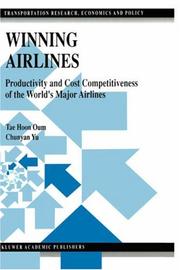
ISBN: 079238010X 1461375045 1461554810 Year: 1998 Volume: v. 6 Publisher: Boston, Mass. Kluwer Academic
Abstract | Keywords | Export | Availability | Bookmark
 Loading...
Loading...Choose an application
- Reference Manager
- EndNote
- RefWorks (Direct export to RefWorks)
Major institutional, regulatory, and structural changes have occurred in international air transport during the past two decades. Many countries have deregulated their domestic airline industries and open skies continental blocs have formed in Europe and North America A movement is now underway to create a liberalized continental bloc in Australasia. International air transport has been substantially liberalized due to the diminishing role of lATA as an industry cartel, and via a series of liberalized bilateral agreements signed between many countries, including the u.s. and UK Increased liberalization and continentalization have induced major airlines to create global service networks through inter-carrier alliances. And all these changes are intensifYing competition between major carriers in both domestic and international markets. The increased competition and economic recession in the early 1990s led many airlines to massive fmancial losses, forcing them to undertake major restructuring to improve efficiency and reduce costs. Although it is important for an airline to map out proper strategies in the globalizing airline industry, the ultimate ability of a carrier to swvive and prosper in increasingly competitive markets greatly depends on its productivity and cost competitiveness.
Air traffic --- Airlines --- Aeronautics, Commercial --- Competition, International. --- Compagnies de transport aérien --- Transports aériens --- Concurrence internationale --- Cost of operation. --- Management. --- Frais d'exploitation --- Gestion --- Compagnies de transport aérien --- Transports aériens --- Regional economics. --- Spatial economics. --- International economics. --- Industrial management. --- Macroeconomics. --- Regional/Spatial Science. --- International Economics. --- Innovation/Technology Management. --- Macroeconomics/Monetary Economics//Financial Economics. --- Economics --- Business administration --- Business enterprises --- Business management --- Corporate management --- Corporations --- Industrial administration --- Management, Industrial --- Rationalization of industry --- Scientific management --- Management --- Business --- Industrial organization --- Administration --- Industrial relations --- Organization --- Economic policy, Foreign --- Economic relations, Foreign --- Economics, International --- Foreign economic policy --- Foreign economic relations --- Interdependence of nations --- International economic policy --- International economics --- New international economic order --- Economic policy --- International relations --- Economic sanctions --- Spatial economics --- Regional economics --- Regional planning --- Regionalism --- Space in economics --- International competition --- World economics --- International trade --- War --- Economic aspects
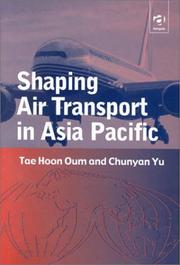
Abstract | Keywords | Export | Availability | Bookmark
 Loading...
Loading...Choose an application
- Reference Manager
- EndNote
- RefWorks (Direct export to RefWorks)
Air traffic --- Far East
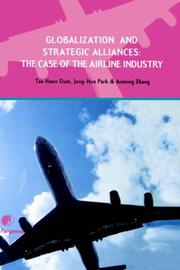
ISBN: 0080435963 Year: 2000 Publisher: Amsterdam Elsevier
Abstract | Keywords | Export | Availability | Bookmark
 Loading...
Loading...Choose an application
- Reference Manager
- EndNote
- RefWorks (Direct export to RefWorks)
In the foreseeable future the alliance will become an increasingly important feature of the airline industry around the world. Despite its growing importance to airline management, aviation policy makers, and research literature, there has not been much rigorous analysis of airline alliances in economics or management literature. It is clear that the authors of this book are among the first researchers to do serious analytical studies and quantitative analysis on airline alliances. Given the growing importance of alliances, there is a clear need for a book that gives a comprehensive and analytical treatment of key aspects of airline alliances. In this book, they accomplish just that. This book presents the past history and current status of airline alliances, reasons why alliances are being formed, analyzes the questions 'why are alliances likely to remain a key fixture of the airline industry in the foreseeable future?' and 'what implications do alliances have on carrier management and public policy makers', and quantifies the key economics effects of airline alliances.
Industrial economics --- International economic relations --- Air traffic --- Airlines. --- Globalization. --- Strategic alliances (Business). --- Geografie --- Economische geografie --- Transport.
Book
ISBN: 9783319065236 331906522X 9783319065229 3319065238 Year: 2015 Publisher: Cham : Springer International Publishing : Imprint: Springer,
Abstract | Keywords | Export | Availability | Bookmark
 Loading...
Loading...Choose an application
- Reference Manager
- EndNote
- RefWorks (Direct export to RefWorks)
While intercity passenger transport counts for about 2% of the total passenger transport volume the share of the total passenger kilometers traveled is estimated more than one third. In many countries the major part of intercity transport is performed by car and air and as a result, the contribution to the carbon footprint is substantially higher than the share of overall passenger transport performance. This creates a challenge to develop a sustainable organization of intercity transport which requires a true joint effort of policy makers, industry sectors and households. This presupposes that all options for reducing the carbon footprint of the transport modes – car, air and rail – are fully exploited through modern propulsion technology, use of regenerative energy and efficient organization of transport processes. Basic conditions for meeting this requirement are an incentive compatible public framework of regulation, taxation, charging and education, the private willingness to adjust to new behavioral patterns and a consequent push of technological progress towards energy and CO2 savings. This book begins with an international comparison of intercity transport and the current state of greenhouse gas emissions (GHG) of this transport segment. A focus is given to comparing the situation in the EU, the US and Japan while describing the more recent development of intercity transport in China, followed by an analysis of intercity transport policies and their contribution to meet the global climate change issues. This book will be of interest to researchers in transportation economics and policy, as well as civil engineering and planning.
Economics/Management Science. --- Economics/Management Science, general. --- Transportation. --- Climate Change Management and Policy. --- Civil Engineering. --- Economics. --- Civil engineering. --- Economie politique --- Génie civil --- Business & Economics --- Economic Theory --- Transportation --- Greenhouse gas mitigation. --- Passenger traffic. --- Climatic factors. --- Passenger traffic --- Passenger transport --- Passenger transportation --- Abatement of greenhouse gas emissions --- Emission reduction, Greenhouse gas --- Emissions reduction, Greenhouse gas --- GHG mitigation --- Greenhouse gas abatement --- Greenhouse gas emission reduction --- Greenhouse gas emissions reduction --- Greenhouse gas reduction --- Mitigation of greenhouse gas emissions --- Reduction of greenhouse gas emissions --- Climate change. --- Environmental economics. --- Environmental Economics. --- Pollution prevention --- Climatology --- Engineering --- Public works --- Economics --- Environmental quality --- Environmental aspects --- Economic aspects --- Changes, Climatic --- Changes in climate --- Climate change --- Climate change science --- Climate changes --- Climate variations --- Climatic change --- Climatic changes --- Climatic fluctuations --- Climatic variations --- Global climate changes --- Global climatic changes --- Climate change mitigation --- Teleconnections (Climatology) --- Public transportation --- Transport --- Transportation, Primitive --- Transportation companies --- Transportation industry --- Locomotion --- Commerce --- Communication and traffic --- Storage and moving trade --- Global environmental change
Digital
ISBN: 9783319065236 9783319065243 9783319065229 9783319352589 Year: 2015 Publisher: Cham Springer International Publishing
Abstract | Keywords | Export | Availability | Bookmark
 Loading...
Loading...Choose an application
- Reference Manager
- EndNote
- RefWorks (Direct export to RefWorks)
While intercity passenger transport counts for about 2% of the total passenger transport volume the share of the total passenger kilometers traveled is estimated more than one third. In many countries the major part of intercity transport is performed by car and air and as a result, the contribution to the carbon footprint is substantially higher than the share of overall passenger transport performance. This creates a challenge to develop a sustainable organization of intercity transport which requires a true joint effort of policy makers, industry sectors and households. This presupposes that all options for reducing the carbon footprint of the transport modes – car, air and rail – are fully exploited through modern propulsion technology, use of regenerative energy and efficient organization of transport processes. Basic conditions for meeting this requirement are an incentive compatible public framework of regulation, taxation, charging and education, the private willingness to adjust to new behavioral patterns and a consequent push of technological progress towards energy and CO2 savings. This book begins with an international comparison of intercity transport and the current state of greenhouse gas emissions (GHG) of this transport segment. A focus is given to comparing the situation in the EU, the US and Japan while describing the more recent development of intercity transport in China, followed by an analysis of intercity transport policies and their contribution to meet the global climate change issues. This book will be of interest to researchers in transportation economics and policy, as well as civil engineering and planning.
Economics --- Meteorology. Climatology --- Environmental protection. Environmental technology --- Transport. Traffic --- Civil engineering. Building industry --- economie --- milieuzorg --- transport --- ingenieurswetenschappen --- klimaatverandering --- broeikaseffect
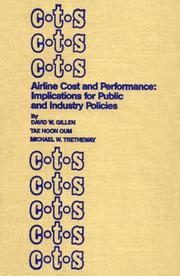
ISBN: 091980439X Year: 1985 Publisher: Vancouver
Abstract | Keywords | Export | Availability | Bookmark
 Loading...
Loading...Choose an application
- Reference Manager
- EndNote
- RefWorks (Direct export to RefWorks)
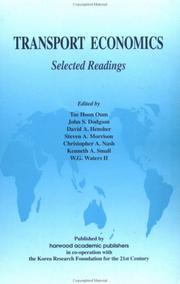

ISBN: 9057021862 9789057021862 Year: 1997 Publisher: Amsterdam Harwood
Abstract | Keywords | Export | Availability | Bookmark
 Loading...
Loading...Choose an application
- Reference Manager
- EndNote
- RefWorks (Direct export to RefWorks)
656 --- Transportation --- -Public transportation --- Transport --- Transportation, Primitive --- Transportation companies --- Transportation industry --- Locomotion --- Commerce --- Communication and traffic --- Storage and moving trade --- 656 Transport and postal services. Traffic organization and control --- Transport and postal services. Traffic organization and control --- Costs --- Economic aspects --- -Transport and postal services. Traffic organization and control --- Public transportation --- Transportation. --- Costs. --- 656 Transport en postdiensten. Verkeersorganisatie en controle --- Transport en postdiensten. Verkeersorganisatie en controle --- Transportation - Costs.
Book

Year: 1993 Publisher: Osaka Osaka university
Abstract | Keywords | Export | Availability | Bookmark
 Loading...
Loading...Choose an application
- Reference Manager
- EndNote
- RefWorks (Direct export to RefWorks)
Book

ISBN: 9789814414203 Year: 1997 Publisher: Singapore
Abstract | Keywords | Export | Availability | Bookmark
 Loading...
Loading...Choose an application
- Reference Manager
- EndNote
- RefWorks (Direct export to RefWorks)
| Listing 1 - 10 of 10 |
Sort by
|

 Search
Search Feedback
Feedback About UniCat
About UniCat  Help
Help News
News